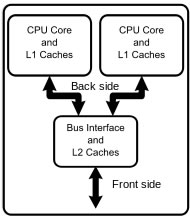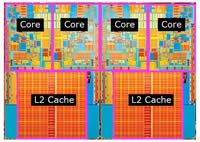Difference between Dual Core and Quad Core
Key Difference: A dual-core processor is a type of a central processing unit (CPU) that has two complete execution cores. Quad-core processors have four independent central processing units that can read and execute instructions.
The constant evolution of computers requires it to be faster, stronger and better. This requirement has been getting companies to butt heads trying to figure out ways to make the computers faster and more powerful processors. This has given birth to technologies such as dual-core and quad-core processors. Dual-core and quad-core are also known as multi-core processors.

A dual-core processor is a type of a central processing unit (CPU) that has two complete execution cores. Hence, it has the combined power of two processors, their caches and the cache controllers onto a single chip. This makes the dual-core processors well-suited for multitasking. Dual-core processors have two cores that have an independent interface to the frontside bus. Each core has its own cache. This allows the operating system to have sufficient resources to handle intensive tasks in parallel.
Dual Core is a generic name for any processor with two cores from any manufacture. However, due to marketing and Intel’s predominance in the CPU market, dual core has become synonymous with Intel Pentium Dual Core. It may sometimes also be used to refer to Intel’s Core 2 Duo line. AMD, the main competitor of Intel, also had a dual-core processor under the x2 brand.
 Quad-core processors are the next step after dual-core. True to its name, quad-core refers to processors that have four independent central processing units that can read and execute instructions. Quad-cores actually comprise two dual-core processors, where processor 1 and 2 would share the same memory cache, while processors 3 and 4 would share one. Incase processor 1 needs to communicate with processor 3; it would have to be through an external frontside bus. Both Intel and AMD have released quad-core processors.
Quad-core processors are the next step after dual-core. True to its name, quad-core refers to processors that have four independent central processing units that can read and execute instructions. Quad-cores actually comprise two dual-core processors, where processor 1 and 2 would share the same memory cache, while processors 3 and 4 would share one. Incase processor 1 needs to communicate with processor 3; it would have to be through an external frontside bus. Both Intel and AMD have released quad-core processors.
Though quad-core is a faster and better technology, it also has some limitations. The true performance of quad-core is often lacking due to external problems. One such problem is heat, each core generates a lot of heat while running, so four cores requires powerful cooling measure such as liquid cooling (which are harder to implant) or to reduce the total speed of the core. This provides a dip in the performance of the cores. Another problem that arises is the hardware, though the processors have been upgraded, the hardware has not yet caught up to the processor. Because of this, during the execution of heavy tasks, the data of the processors could become more congested.
Even though there are minor limitations with the quad-core, it is soon expected to be dealt with. The supporting hardware and software are soon expected to catch up with these cores. Other multiple-core processors are also in the works including a hexa-core processor, which contains six cores and an octa-core processor, which contains eight cores.
Image Courtesy: en.wikipedia.org, anandtech.com









Comments
wil
Sat, 07/01/2017 - 17:21
Charles Caro
Wed, 05/17/2017 - 06:45
Thank you Charles, for pointing out that typo. It has been fixed.
dbadmin
Wed, 05/17/2017 - 10:53
Harp
Thu, 11/26/2015 - 17:52
thnks guys for this informition
Azhar
Thu, 02/06/2014 - 17:37
Add new comment